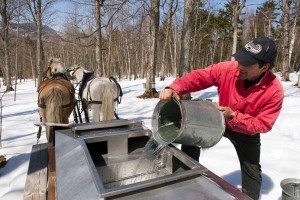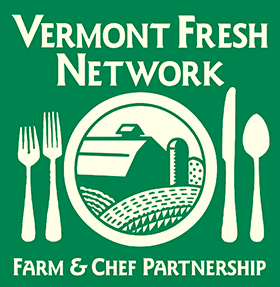Vermont’s Best, Truly-Local, Cuisine
Chef Scot Emerson recently spent $8,000 on one steer. It’s not just any steer, but one of a small herd of Vermont Wagyu, carefully bred from a strain of Japanese beef cattle, grass-fed and raised on Springfield, Vt.’s 350-acre Spring Rock Farm.
“It’s incredible meat,” Emerson says. “I now have 14 tenderloins, each about 3 inches thick, that I’m probably going to put on the menu for about $140 a plate at Coleman Brook Tavern.”
Really? $140 for a steak? “Yup,” says Emerson, “and I think they’ll go fast.” And under his new “whole animal” program, Emerson plans to use nearly every piece of the animals he buys across the resort’s 11 restaurants.
Oxtail might be used in broth for a delicate noodle soup, while ground beef from the steer might show up in burgers. He creates a mean variation on baked brie with a local Vermont Farmstead cheese called Lillé and you can get his recipe and watch a video how to make it.

“Our goal is to let skiers have a wide variety of dining experiences across the resort,” he says.
As executive chef at Okemo Mountain Resort and a former chef at The Greenbrier Resort in West Virgina, Emerson knows where to find the best ingredients and what customers want. And he tries to keep it local and sustainable.
Emerson sources his lamb and honey from Smokeshire Hilltop Farm in Chester. The farm not only raises lamb, berries, turkeys and honey, but does so on a minimal footprint.

Energy comes from solar, wind, biodiesel and wood. Draft horses are used for logging and plowing.
“I was an early member of the Vermont Fresh Network,” Emerson says of the non-profit that has been linking local chefs with farms for more than 20 years. “I really believe in the small farms we have in Vermont and what they can produce.”
The Vermont Fresh Network (VFN) not only links farms with chefs, but certifies restaurants that source a certain percentage of their food locally with the VFN logo. “A
lot of people say they buy local,” says VFN executive director Meghan Sheridan. “We actually go out and audit restaurants and make sure they are practicing what we preach.”
Okemo’s Coleman Brook Tavern is one of an elite handful that have earned VFN’s “Gold Barn” status for purchasing more than 30 percent of its food from Vermont producers.
In the past year, Vermont Fresh Network chefs invested $25 million in local food. Sugarbush’s executive chef Gerry Noonan is one of them. This past fall Noonan put away more than 2,000 pounds of produce grown at the Mad River Valley’s Gaylord Farm, which raises certified organic vegetables and natural meats, to use at Sugarbush’s The Timbers and Allyn’s Lodge. “Last year, we had enough tomatoes to make local tomato soup all year and served it with a grilled cheese sandwich made with Cabot’s Legacy collection Alpine Cheddar.” Noonan will also get a Misty Knoll chicken from Addison County or a side of beef raised in Shelburne to roast over the open fire at the special on-mountain dinners he puts on at Allyn’s Lodge. He uses Nitty Gritty Grain from Addison County for his wood-fired pizzas.

Stowe’s mountaintop restaurant, the Cliff House, is also a Vermont Fresh Network member and has made a practice of hosting special farm-to-table dinners through the season. While the restaurant at the top of the gondola serves locally-sourced dishes, such as grass-fed Vermont burger and cider-brined pork chops for lunch, its special farm-to-table dinners are worth signing up for months in advance and often pair local fare with local ciders, beers or wines.
“It’s obviously easier for smaller and specialty restaurants to buy and serve local food,” says VFN’s Sheridan, noting that at the large ski resorts, it’s usually just a few of the restaurants, not all of them, that have VFN status.
At cross-country resorts, though, the eateries are smaller and more intimate. VFN member Trapp Family Lodge, for instance, not only buys much of its food locally, it also raises it. Sheep and cattle help keep the grasses on the cross-country trails cut short in the summer and become part of the menu in the fall and winter. Trapp’s gardens supply berries and vegetables and the sugarhouse and new on-site brewery provide Vermont’s two best-known elixirs: maple syrup and craft beer.

At the Strafford Nordic Center, the base lodge and trail head are at Rockbottom Farm, which also happen to be headquarters for the Strafford Organic Creamery—makers of exceptional ice cream and other dairy products. Montpelier’s Morse Farm is not only a sweet place to cross-country ski, it’s an even sweeter place in the spring when the sugarhouse is running. Other resorts that are VFN members include Red Clover Inn, Blueberry Hill, Craftsbury Outdoor Center, the Mountain Top Inn and The Woodstock Inn.
“Increasingly,” says Emerson, “all mountains are offering great skiing. Skiers are going to choose where they go based on who has good food. And Vermont is someplace they will find it. ” —Lisa Lynn
To find a Vermont Fresh Network member restaurant, look for the VFN logo or visit www.vermontfresh.net


